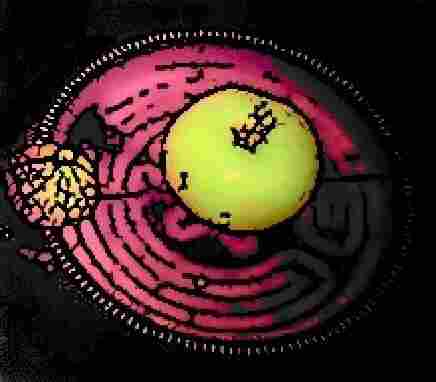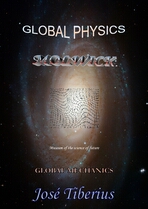3.b) Evolution and history of the atomic model
The structure of matter has been the focus of study and analysis since the dawn of modern civilization. The word atom comes from the Greek word (of the same phonetic pronunciation) which meant indivisible; that is, the smallest unit of matter, mass, or however the Greeks called it.
The current meaning of the atom comes from its evolution in the 19th century, and in the last century, scientists discovered there were subatomic particles. Therefore, it began the elaboration of the current structure of the atom, or interrelation of the types of smallest elementary particles that make up the atom.
Given the importance of the evolution of the different atomic models developed, let us briefly comment on the history of the atom in chronological order before showing the current atom model put forth by Global Mechanics.
450 BC – Atomic model of Democritus
The philosophical development by Democritus postulated the impossibility of an infinite division of matter, so there should be the smallest unit of which all substances would consist.
It is interesting to think that for 2,500 years Democritus was right; the truth is that it seemed to be so, but now one of the most critical theories or ideas in Global Mechanics presents the exact opposite notion.
In the current model of Global Physics, all substances make up a unique particle called Global Aether, which consists of an unbreakable three-dimensional reticular network that extends throughout the universe.
1808 – Atomic model of Dalton
The development of the Dalton model already pointed the way to the modern atom, but as a single particle, although it was not very clear at first if the atomic model of Dalton was supposed to be an atom or a molecule.
1897 – Atomic model of Thomson
The following major step in the history of the modern atom was the atomic theory of Thomson, with the division of the atom in positive and negative charges, like a fruitcake or garlic soup, with electrical forces of attraction.
1911 – Atomic model of Rutherford
The Rutherford model separates the nucleus with a positive charge from electrons with negative charge.
Atom Model of de Rutherford 
Electrons are in circular or elliptical orbits around the nucleus. The Rutherford model in 1920 added the neutron theoretically, confirmed experimentally in 1932.
The Rutherford model is the visual image we all have of the modern atom, but it had two problems:
It contradicted the Maxwell laws of electromagnetism, in which charged particles in movement should constantly be emitting photons. Therefore, electrons should lose energy and fall towards the nucleus of the atom.
-
The atomic theory of Rutherford did not explain the atomic spectrum.
1913 – Atomic model of Bohr
The atomic theory of Bohr introduced substantial improvements to the Rutherford model by incorporating energy aspects derived from Planck energy and the photoelectric effect.
Although a detailed description of the Bohr model is complicated, the following characteristics are relevant in regards to the model that Global Mechanics, is going to introduce:
- Electrons are in stable circular orbits; that is, where they do not emit energy and not allowing all orbits.
- The allowed electron orbits in the Bohr atomic model have an angular momentum that is an exact multiple of h-bar –the Planck constant divided by 2π.
- Electrons emit or absorb a photon by changing atomic orbits, the energy of which depends on the difference of energy of the orbits and they do not need to pass through intermediate states.
- In the Bohr atom, the electron orbits follow the rules of Classical Mechanics but the orbit changes do not.
Regardless of the enormous success of this model in many aspects, the problem with the Bohr model, and with the whole of Quantum Mechanics, is that they go on adding assumptions throughout history, but without explaining the reasons to justify them. They work and better explain reality; which, although it is not at all bad, does not help very much with the understanding of reality if the reasons themselves base on misleading physics principles.
They could have tried a plausible explanation for a change.
1916 – Atomic model of Sommerfeld
The development of the Sommerfeld model includes sublevels within the Bohr atom structure, dismisses circular orbits and, to a certain extent, incorporates Theory of Relativity.
The Sommerfeld model also makes electrons out to be an electrical current, and it does not explain why orbits must be elliptical. We believe they are ellipsoids, and that Sommerfeld is right in that the electron is a special kind of electromagnetic wave, wavon in Global Mechanics.
1926 – Schrödinger model, or current model according to Wikipedia
The Schrödinger model alters the philosophy of orbits –most certainly because of its new contributions to the atomic theory of De Broglie regarding the wavelike nature of mass in 1924– and describes electrons with wave functions. This configuration allows us to determine the probability of finding the electron at a specific point in space. In this way, we obtain orbitals of spatial density of probability of finding an electron.
This model of the Schrödinger atom adapts much better to observations; however, by giving up the previous image of the shape of orbits, it moves away from an intuitive explanation regarding the causes of such arbitrary orbits.
At the same time, Schrödinger goes into the world of probabilities and of mathematical abstraction, which, in large doses, could end up being very detrimental.
2008 – Evolution of the current model of an atom
In the following section, this online book of Global Mechanics proposes a new step in the evolution of the modern model of the atom in an attempt to continue to make progress in our knowledge of a physics reality that is as beautiful and simple as it is complicated.
